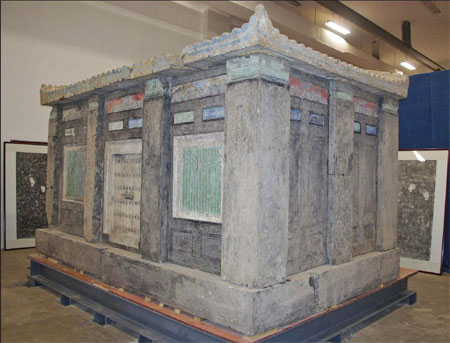Society
Tomb raiders remain a menace
Updated: 2011-09-09 14:26
By Zhang Yan (China Daily European Weekly)
|
 The 27-ton coffin container, taken from the tomb of Wu Huifei (AD 699-737), a concubine of Tang Xuanzong (AD 685-762), the seventh emperor of the Tang Dynasty, has been returned to China from the US. [Photos Provided to China Daily] |
Diminishing resource
"If we don't take immediate and effective steps to protect these artifacts, there will be none of these things left to protect in 10 years," Luo Xizhe , director of the Shaanxi Provincial Cultural Relics Bureau's heritage inspection and safety department.
Some of the most notorious cases of tomb raiding have occurred in Shaanxi province's Xi'an, a city once known as Chang'an, which was the capital of the Zhou, Qin, Han, Tang dynasties and nine other Chinese imperial dynasties.
Civilization has existed in Shaanxi since the 11th century BC, and so it contains some of the oldest cultural artifacts in the world.
The State has granted the highest level of official protection to 139 heritage sites in Shaanxi. Most famous among them is the tomb of Qin Shi Huang, the first emperor of China, who was buried with an army of terracotta warriors. Elsewhere, among the 900,000 cultural artifacts kept at 70 museums in the province, are 3,256 pieces that are considered to be of the highest quality.
"The rich heritage of Shaanxi has made the province the main target of grave robbers, largely because of its large numbers of high-quality, rare and valuable artifacts," Luo said.
Since 2009, the Shaanxi police cracked more than 250 tomb-raiding cases, detaining 500 suspects, according to statistics from the Shaanxi public security department. They have also recovered 1,500 cultural artifacts, including 10 that are considered to be of the highest quality.
"Nearly all the ancient tombs that are clearly marked bear evidence that they have been raided repeatedly," he said, adding that in some places where ancient tombs are subject to special protection, dozens of holes have been found indicating people had been trying to probe the contents of the earth.
In Shaanxi, most of the members of tomb-raiding gangs hail from Henan, Shanxi, Gansu and Shaanxi provinces. They are often villagers who are from 30 to 50 years old and who have acquired special techniques that come in useful in stealing cultural artifacts, Wu Zhongfei, deputy director of Shaanxi Provincial Public Security Bureau's criminal investigation department, told China Daily in an exclusive interview.
"They are often directed by a gang leader who stays behind and works with villagers to commit the crime," Wu said."Farmers are much more familiar with the local terrain. They usually help a gang to find a tomb site, and give them a place to take shelter in and hide from the police."
Two insiders in the artifact trade in Shaanxi who declined to state their full names said, "There are almost 100,000 professional tomb raiders here who can provide supplies to us. "
"An average of four to five professional gangs that raid tombs exist in each of the worst-hit counties in Shaanxi, and some gangs even have established some kind of relationship with the local government and manage to establish deep roots," said a police officer who is responsible for investigating artifacts crimes in Shaanxi and who declined to provide his full name.
Preventative measures
Wu said the Shaanxi police and the provincial cultural heritage bureau are fighting these crimes by establishing a law enforcement agency charged specifically with protecting artifacts.
They also plan to ask villagers to join a full-time patrol team that will keep a vigil in protected areas near historical graves, especially at night.
In the next five years, the State Administration of Cultural Heritage and Shaanxi Provincial Cultural Department plan to spend more than 100 million yuan ($15.6 million) on equipment to monitor ancient tombs.
Most graves now have no monitoring system protecting them, Luo said.
"We have so little money," he said. "And to monitor just one small grave we need at least 5 million yuan to install monitoring equipment, including video surveillance equipment that can be used in the daytime and infrared thermal imaging devices to be used at night."
E-paper

Way over the moon
High inflation rockets mooncake prices out of orbit for mid-autumn festival
From death matches to child's play
Tomb raiders remain a menace
Kicking for joy
Specials

Singing success
Western musicians bring much-needed impetus to live performance industry

Salary bonanza for bosses
Top boss gets 8.78 million euros a year, far more than the State enterprise CEO with highest pay

Kicking for joy
Swedish college student represents China in Taekwondo championships
